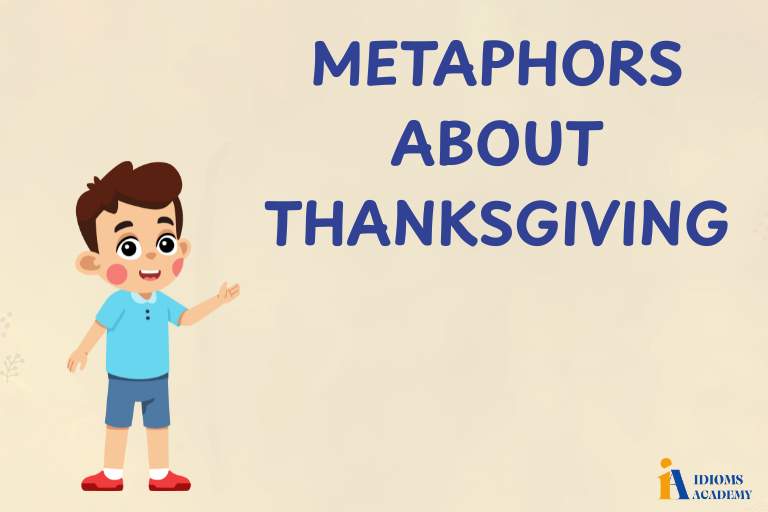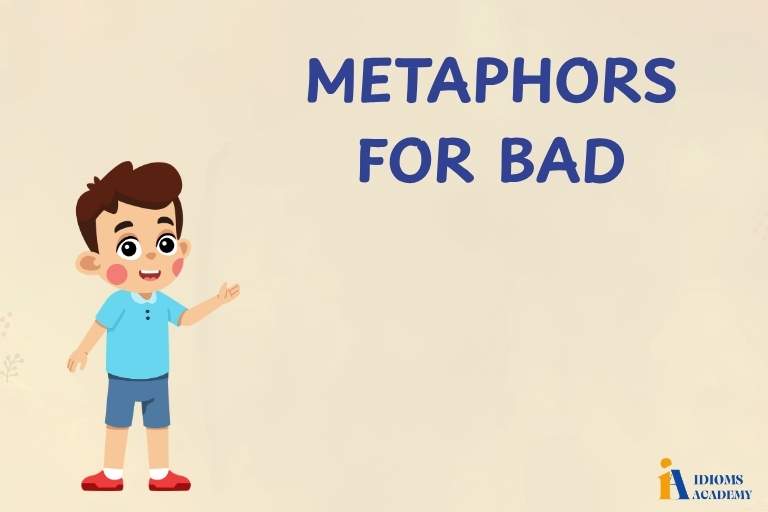Sometimes when people are hurt, they need time and care to feel better. This is called healing. Healing doesn’t always happen with medicine. It can also mean feeling better in your heart or mind after something sad or hard. People often use metaphors to talk about healing. A metaphor is when you describe something by comparing it to something else. For example, someone might say, “Time is a bandage,” to show that time helps people feel better.
In this article, you will learn about different metaphors people use for healing. These comparisons help us understand feelings in a simple way. They make hard ideas easier to picture. As you read, think about how these ideas help people talk about pain and feeling better. Let’s take a closer look at what healing can mean.
Metaphors for Healing
1. Time is a bandage
Meaning: Time helps you feel better after something painful.
Example Sentence:
- After her dog passed away, time was a bandage for her sadness.
- When he moved to a new school, time was a bandage that helped him adjust.
Other ways to say: Time heals all wounds. Time helps pain fade.
Fun Fact/Origin: This idea comes from the belief that emotional pain gets smaller as days go by.
Usage: Used when someone needs time to feel better after a hard moment.
2. Healing is a journey
Meaning: Getting better takes time and happens step by step.
Example Sentence:
- Healing from surgery was a journey for him.
- After her loss, healing felt like walking down a long road.
Other ways to say: Step by step recovery. Slow and steady healing.
Fun Fact/Origin: This comes from the idea that getting better is like going on a trip.
Usage: Used when healing takes time and effort.
3. Scars are stories
Meaning: Scars show where someone has been hurt and healed.
Example Sentence:
- Her scar was a story of strength.
- That scar on his hand told a story from when he learned to cook.
Other ways to say: Scars show survival. Scars are proof of healing.
Fun Fact/Origin: People have shared the meaning of their scars for centuries.
Usage: Used to show that scars are not just marks, but memories.
4. Healing is like growing a garden
Meaning: Healing takes time, care, and patience.
Example Sentence:
- She treated her feelings like a garden, giving them care.
- His healing grew like a plant in sunlight.
Other ways to say: Healing takes care. Recovery grows slowly.
Fun Fact/Origin: People compare personal growth to how plants grow.
Usage: Used when healing needs attention and kindness.
5. A heart can bloom again
Meaning: Someone can feel joy again after sadness.
Example Sentence:
- After losing her pet, her heart bloomed again when she got a new puppy.
- He smiled more and more—his heart was blooming again.
Other ways to say: Love can return. Happiness can grow.
Fun Fact/Origin: Like flowers blooming in spring, hearts can heal and open again.
Usage: Used when someone begins to feel happy again.
6. Healing is like mending a quilt
Meaning: Fixing small parts slowly helps the whole feel better.
Example Sentence:
- She mended her broken feelings like sewing a quilt.
- He fixed his heart one patch at a time.
Other ways to say: Putting the pieces back. Repairing little by little.
Fun Fact/Origin: Quilts are often sewn by hand, one patch at a time, just like healing.
Usage: Used for slow, careful emotional healing.
7. Healing is a sunrise
Meaning: A new beginning comes after darkness or sadness.
Example Sentence:
- After his hard year, healing felt like a sunrise.
- Her smile came back like the sun after night.
Other ways to say: A new day begins. Light after darkness.
Fun Fact/Origin: Sunrise is often used to show hope and fresh starts.
Usage: Used when someone feels better after tough times.
8. Emotions are waves
Meaning: Feelings come and go, just like waves in the ocean.
Example Sentence:
- Some days he was sad, others not. His emotions were waves.
- Her healing had ups and downs, like waves at the beach.
Other ways to say: Feelings rise and fall. Mood shifts like the sea.
Fun Fact/Origin: The ocean has long been used to explain how emotions move.
Usage: Used to show healing is not always a straight path.
9. Healing is a puzzle
Meaning: Many small pieces come together to feel whole again.
Example Sentence:
- Each good day was a piece of his healing puzzle.
- She put herself back together like a puzzle.
Other ways to say: Piece by piece. Finding the missing parts.
Fun Fact/Origin: Puzzles need time and focus, just like healing.
Usage: Used for emotional or mental healing over time.
10. Healing is like learning to walk again
Meaning: It can be hard at first, but gets easier over time.
Example Sentence:
- At first it was hard, but healing felt like learning to walk again.
- He wobbled at first, then got stronger.
Other ways to say: Starting fresh. Getting your strength back.
Fun Fact/Origin: Doctors often help people relearn to walk after injury—emotionally, it’s similar.
Usage: Used when someone is recovering slowly and carefully.
11. Broken bones teach strength
Meaning: Pain can help someone grow stronger.
Example Sentence:
- After his accident, he was stronger in many ways.
- Her broken arm helped her learn to be brave.
Other ways to say: Pain builds strength. Hard things teach us.
Fun Fact/Origin: Bones often grow back stronger after healing.
Usage: Used to show that healing teaches lessons.
12. Healing is like cleaning a room
Meaning: It takes effort and makes you feel better afterward.
Example Sentence:
- Clearing her sad thoughts was like cleaning her messy room.
- He felt better after talking—it was like cleaning inside.
Other ways to say: Making space. Clearing out the mess.
Fun Fact/Origin: Cleaning is often used to explain removing bad feelings.
Usage: Used for emotional or mental healing.
13. Wounds are windows
Meaning: Pain can help people understand and grow.
Example Sentence:
- His sadness became a window into what mattered most.
- Her hurt showed her what she cared about.
Other ways to say: Pain opens your eyes. Hurt helps you see.
Fun Fact/Origin: Writers often compare pain to windows that let in new light.
Usage: Used when someone learns something from pain.
14. Healing is a warm blanket
Meaning: It gives comfort and safety after being hurt.
Example Sentence:
- Her friends were like a warm blanket during her healing.
- His healing came with comfort, like a soft blanket.
Other ways to say: Comfort and care. Wrapped in love.
Fun Fact/Origin: Blankets often mean safety and warmth in stories.
Usage: Used to describe safe, peaceful recovery.
15. The heart stitches itself
Meaning: The heart can slowly fix its own pain.
Example Sentence:
- Her heart stitched itself after the loss.
- Time helped his heart stitch up the tear.
Other ways to say: The heart repairs. Slow healing inside.
Fun Fact/Origin: This idea compares hearts to fabric that can be sewn back together.
Usage: Used for quiet, slow healing of feelings.
16. Healing is like climbing a hill
Meaning: It’s hard at first, but gets easier as you go.
Example Sentence:
- Healing after surgery felt like climbing a steep hill.
- Each day got better, like reaching the top.
Other ways to say: Step by step uphill. Getting stronger with each step.
Fun Fact/Origin: Climbing is often used to show effort and progress.
Usage: Used when healing feels slow but keeps moving forward.
17. Tears are rain for the soul
Meaning: Crying helps clean out sadness and helps healing.
Example Sentence:
- Her tears were rain that helped her grow.
- Crying helped him feel better, like a rainstorm washing things away.
Other ways to say: Crying brings calm. Tears help heal.
Fun Fact/Origin: Rain helps plants grow. People often compare tears to rain for emotions.
Usage: Used when showing that crying can be helpful.
18. The heart is a puzzle
Meaning: It takes time to put feelings back together.
Example Sentence:
- After the breakup, her heart felt like a puzzle with missing pieces.
- He slowly fit the pieces of his heart back together.
Other ways to say: Fixing the heart. Putting feelings back.
Fun Fact/Origin: Puzzles are used to explain complex emotions in a simple way.
Usage: Used to describe emotional healing.
19. Healing is a slow dance
Meaning: It moves gently and takes time.
Example Sentence:
- Her healing was a slow dance of ups and downs.
- He moved through his feelings like a slow dance.
Other ways to say: Gentle steps. Moving slowly.
Fun Fact/Origin: Dances are often used to show rhythm and timing.
Usage: Used to show peaceful, slow emotional growth.
20. Words are medicine
Meaning: Kind words help someone feel better.
Example Sentence:
- His friend’s kind words were like medicine.
- She felt better after her teacher’s caring words.
Other ways to say: Words can heal. Talking helps.
Fun Fact/Origin: Long ago, people believed in the power of spoken words to heal.
Usage: Used when kind speech supports someone’s healing.
21. Smiles are stitches
Meaning: Smiles help fix emotional pain.
Example Sentence:
- Each smile was a stitch that helped her heart heal.
- His smiles helped sew up the sadness.
Other ways to say: Smiles bring peace. Smiles help mend.
Fun Fact/Origin: Stitches are used to close wounds—smiles do something similar for feelings.
Usage: Used when someone is starting to feel better emotionally.
22. Laughter is glue
Meaning: Laughter brings people together and helps healing.
Example Sentence:
- Their jokes were glue that held them strong during hard times.
- Laughter helped him stick the pieces of life back together.
Other ways to say: Laughter brings healing. Laughter helps fix pain.
Fun Fact/Origin: Laughter can help reduce stress, which helps healing.
Usage: Used when joy supports someone who is hurting.
23. Healing is like repainting a wall
Meaning: You cover the hurt and make things look new again.
Example Sentence:
- She painted over her sadness, like repainting a wall.
- A fresh start helped him cover the pain.
Other ways to say: Starting fresh. Making it new again.
Fun Fact/Origin: Repainting is often used to show change and renewal.
Usage: Used for emotional healing or starting over.
24. The heart is a sponge
Meaning: It soaks up pain but also lets it go over time.
Example Sentence:
- Her heart soaked up the sadness but slowly let it out.
- He felt full of pain, but the sponge started to dry.
Other ways to say: Feeling full of emotions. Letting pain go.
Fun Fact/Origin: Sponges soak in water like people absorb feelings.
Usage: Used to show someone taking in pain but slowly feeling better.
25. Healing is a campfire
Meaning: It gives warmth, light, and brings people together.
Example Sentence:
- Their talks around the fire helped her heal.
- His heart warmed up like a campfire.
Other ways to say: Healing brings warmth. Comfort through connection.
Fun Fact/Origin: Campfires are known for comfort and storytelling.
Usage: Used when connection or care helps someone heal.
26. A broken heart can beat again
Meaning: Even when hurt, the heart can work and feel love again.
Example Sentence:
- Her broken heart learned to beat again after time.
- He thought he’d never feel joy again, but his heart beat once more.
Other ways to say: Love returns. Joy comes back.
Fun Fact/Origin: This phrase helps show that feelings can be strong again.
Usage: Used after loss or sadness when feelings improve.
27. Healing is planting seeds
Meaning: You start small, and things grow over time.
Example Sentence:
- Each kind act was a seed of healing.
- Her smile was a sign that something was growing.
Other ways to say: Starting small. Growing from pain.
Fun Fact/Origin: Seeds grow into something strong—like healing starts small but grows.
Usage: Used when new beginnings help someone get better.
28. Music is medicine
Meaning: Listening to music can help people feel better.
Example Sentence:
- Her favorite song was medicine for her heart.
- He felt better every time he played his guitar.
Other ways to say: Music helps heal. Songs bring peace.
Fun Fact/Origin: Music therapy is used in hospitals to help people relax and heal.
Usage: Used when music brings comfort or joy.
29. The mind is a garden
Meaning: Good thoughts help healing grow.
Example Sentence:
- She planted kind thoughts in her mind-garden.
- He watered his hopes like flowers in his head.
Other ways to say: Think positive. Grow kind thoughts.
Fun Fact/Origin: This comes from the idea that good thoughts grow like plants.
Usage: Used when healing is supported by thinking in healthy ways.
30. A hug is a bandage
Meaning: Hugs help comfort people when they’re hurt.
Example Sentence:
- Her mom’s hug was a bandage for her worries.
- He felt better after a long hug from his friend.
Other ways to say: Hugs help heal. Warm arms bring peace.
Fun Fact/Origin: Hugs can lower stress and help people feel safe.
Usage: Used when comfort comes from someone you trust.
31. Hope is a light
Meaning: Hope helps people see through dark or sad times.
Example Sentence:
- Even in her sadness, hope was a light.
- He held on to a small light of hope.
Other ways to say: Hope shines. A spark of belief.
Fun Fact/Origin: People often say light shows the way, just like hope does.
Usage: Used when someone keeps going with hope.
32. Healing is like building a bridge
Meaning: You connect where you are now to where you want to be.
Example Sentence:
- Each good choice helped her build a bridge to peace.
- He worked hard to cross the bridge of healing.
Other ways to say: Crossing over. Moving forward.
Fun Fact/Origin: Bridges help people cross gaps—healing does too.
Usage: Used when working toward feeling better.
33. Pain is a teacher
Meaning: Hurt can help you learn and grow.
Example Sentence:
- The hard time taught him something new.
- Her pain showed her what mattered most.
Other ways to say: Lessons from pain. Growth through hard times.
Fun Fact/Origin: Teachers help us learn—pain sometimes does too.
Usage: Used to show how healing brings wisdom.
34. Healing is a fresh coat of paint
Meaning: It covers old hurts and makes things feel new.
Example Sentence:
- Her room felt fresh, like her heart.
- He painted his world with hope again.
Other ways to say: A new look. Starting fresh.
Fun Fact/Origin: Painting often stands for change and new starts.
Usage: Used for renewal and emotional repair.
35. Rest is medicine
Meaning: Sleep and quiet time help the body and heart feel better.
Example Sentence:
- She needed rest to feel better.
- Rest was the best medicine after his illness.
Other ways to say: Sleep helps heal. Quiet brings strength.
Fun Fact/Origin: Doctors often say rest is just as important as medicine.
Usage: Used when recovery comes from sleep or calm.
Quiz: Metaphors for Healing
Instructions: Choose the correct meaning for each metaphor. Each question has one correct answer. Use what you’ve learned from the metaphors to find the best choice.
Question Key
1. What does the metaphor “healing is a journey” mean?
A) Healing is like driving a car fast.
B) Healing takes time and happens in steps.
C) Healing is only for people who are sick.
2. If someone says “kind words are medicine,” what are they saying?
A) Words can help people feel better.
B) You have to go to the doctor for kind words.
C) Only medicine works, not words.
3. What does it mean if a person’s “heart is a puzzle”?
A) Their heart is broken forever.
B) Their feelings are confusing, but they can fit back together.
C) They like playing puzzles.
4. What does “healing is like planting seeds” mean?
A) You need a garden to feel better.
B) Healing starts small and grows with care.
C) You must water yourself to heal.
5. If someone says “laughter is glue,” what are they trying to say?
A) Laughter sticks things to your hand.
B) Laughter helps people feel better and stay close.
C) You should use glue to be funny.
6. What does it mean if someone says “healing is a slow dance”?
A) You have to dance to get better.
B) Healing happens at a quick pace.
C) Healing takes time and gentle steps.
7. Why might someone say “a hug is a bandage”?
A) Hugs help cover real cuts.
B) A hug can bring comfort and care like a bandage.
C) Bandages only fix broken bones.
8. What does “hope is a light” mean?
A) Hope makes things brighter when you’re feeling lost.
B) You can turn on hope like a lamp.
C) Light is the only thing you need.
9. When someone says “tears are rain for the soul,” what do they mean?
A) Crying is like a storm.
B) Crying helps clean out sadness and helps you grow.
C) You should always cry in the rain.
10. What does “rest is medicine” mean?
A) You only need sleep when you’re sick.
B) Medicine is better than sleep.
C) Getting enough rest can help your body and mind feel better.
Answer Key
- B – Healing takes time and happens in steps.
- A – Words can help people feel better.
- B – Their feelings are confusing, but they can fit back together.
- B – Healing starts small and grows with care.
- B – Laughter helps people feel better and stay close.
- C – Healing takes time and gentle steps.
- B – A hug can bring comfort and care like a bandage.
- A – Hope makes things brighter when you’re feeling lost.
- B – Crying helps clean out sadness and helps you grow.
- C – Getting enough rest can help your body and mind feel better.
Wrapping Up
Healing can take time, and everyone goes through it in their own way. Metaphors help us talk about healing using simple ideas we can picture, like growing a plant or building a bridge. They make it easier to understand feelings.
You might use these metaphors when talking with a friend, writing a story, or thinking about your own healing. The more you notice them, the more you’ll understand how people share deep feelings in clear ways. Keep learning and paying attention to how words can help hearts feel better.




